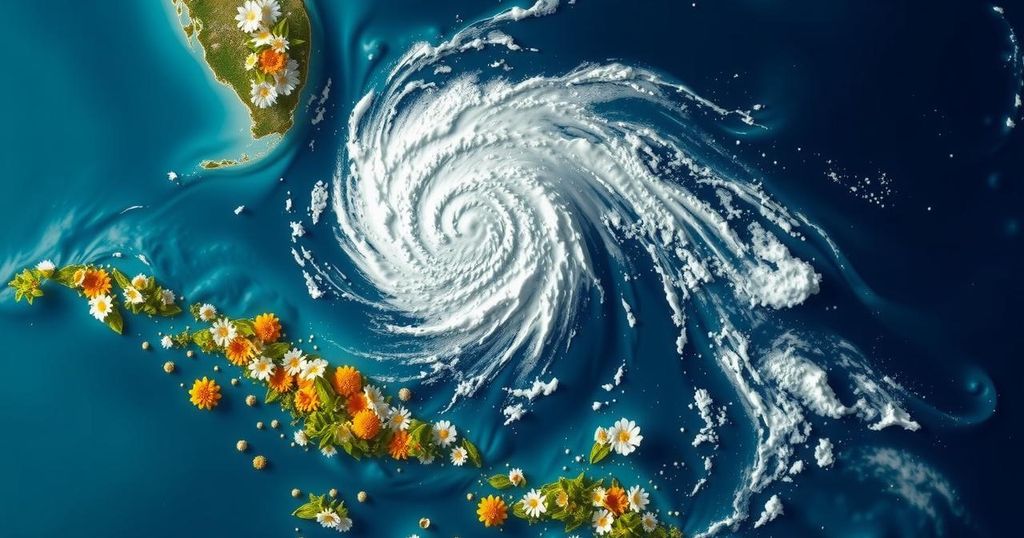Tropical Storm Oscar diminished as it approached the Bahamas after battering Cuba as a Category 1 hurricane, resulting in six fatalities and extensive rainfall. The storm registered as the smallest hurricane on record, and meteorologists expressed surprise over its unexpected intensification. Oscar contributed to ongoing challenges in Cuba, which was still recovering from a massive blackout. The Atlantic hurricane season is projected to produce numerous additional storms as the year concludes.
Tropical Storm Oscar weakened significantly as it progressed toward the Bahamas, following its destructive impact on Cuba where it made landfall as a Category 1 hurricane. The storm resulted in the unfortunate deaths of at least six individuals and caused extensive rainfall across the region, coinciding with a separate power outage crisis in Cuba. As of Tuesday afternoon, Oscar’s remnants were situated approximately 75 miles (115 kilometers) east-southeast of Long Island in the Bahamas, exhibiting maximum sustained winds of 35 mph (55 kph) while traveling northeast at 12 mph (19 kph), as reported by the National Hurricane Center in Miami. Forecasts indicated that these remnants might produce up to 4 inches (10 centimeters) of rainfall over southeastern Bahamas and the Turks and Caicos Islands. Remarkably, Oscar was noted as the smallest recorded hurricane, with a wind field measuring merely 6 miles (10 kilometers) across. Its rapid development caught forecasters unprepared, specifically as it made landfall initially on Grand Inagua Island in the Bahamas before striking Cuba late on Sunday and subsequently turning back toward the Bahamas. Michael Lowry, a recognized hurricane specialist and storm surge expert, pointed out in an analysis, “It’s not often we see a colossal failure in hurricane forecasting,” emphasizing that hurricane prediction models did not anticipate Oscar’s unexpected strengthening into a hurricane. The storm dropped 15 inches (38 centimeters) of rain in certain regions of eastern Cuba, prompting forecasts of significant flooding and potential landslides. The six fatalities occurred in Guantánamo province. This calamity unfolded against the backdrop of Cuba’s ongoing efforts to recover from a substantial blackout, which had ignited minor protests and resulted in governmental warnings against civil unrest. As the 15th named storm and the 10th hurricane of the current Atlantic hurricane season, which spans from June 1 to November 30, Oscar’s impact reflects the intense weather activity predicted due to exceptionally high ocean temperatures. The National Oceanic and Atmospheric Administration has forecasted that the 2023 Atlantic hurricane season may yield between 17 to 25 named storms, including four to seven major hurricanes of Category 3 or higher. Additionally, long-range models predict the potential development of another storm in the central Caribbean in about a week, suggesting that “one last gasp may be in store for the Atlantic as we turn the calendar to November,” as indicated by Mr. Lowry. In the eastern Pacific, Hurricane Kristy was observed strengthening on Tuesday, moving westward at 18 mph (30 kph) with maximum sustained winds reaching 75 mph (120 kph), posing no immediate threat to land.
Tropical Storm Oscar emerged during the Atlantic hurricane season, which runs annually from June to November. The phenomenon of hurricanes and tropical storms is influenced by various climatic factors, including ocean temperatures, atmospheric conditions, and wind patterns. Oscar, notable for being the smallest hurricane on record, surprised meteorologists due to its unexpected strengthening and trajectory changes. The storm’s impacts were compounded by pre-existing challenges faced by Cuba, such as a massive power outage that affected large swaths of the population, leading to a fraught sociopolitical context.
In summary, Tropical Storm Oscar’s journey from Cuba to the Bahamas highlights the unpredictable nature of tropical storm development and forecasting. The storm caused significant destruction in Cuba, including fatalities and flooding, while simultaneously raising concerns about the upcoming hurricane season, characterized by potential for further storm activity. As analysis continues, it underscores the importance of accurate forecasting and preparedness in mitigating the impacts of severe weather events.
Original Source: apnews.com






